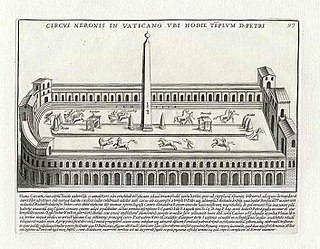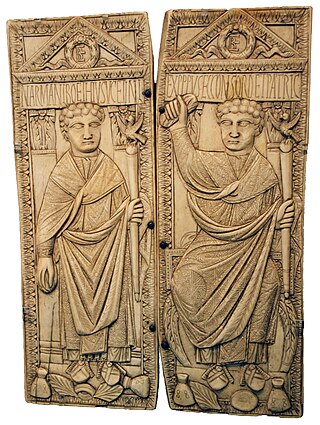
An obelisk is a tall, slender, tapered monument with four sides and a pyramidal or pyramidion top. Originally constructed by Ancient Egyptians and called tekhenu, the Greeks used the Greek term obeliskos to describe them, and this word passed into Latin and ultimately English. Though William Thomas used the term correctly in his Historie of Italie of 1549, by the late sixteenth century, Shakespeare failed to distinguish between pyramids and obelisks in his plays and sonnets. Ancient obelisks are monolithic and consist of a single stone; most modern obelisks are made of several stones.

The so-called Circus of Nero or Circus of Caligula was a circus in ancient Rome, located mostly in the present-day Vatican City.
Manerbio is a town and comune in the province of Brescia, in Lombardy, northern Italy. It received the honorary title of city with a presidential decree on May 14, 1997.

Borgo is the 14th rione of Rome, Italy. It is identified by the initials R. XIV and is included within Municipio I.

The Circus of Maxentius is an ancient structure in Rome, Italy, part of a complex of buildings erected by emperor Maxentius on the Via Appia between AD 306 and 312. It is situated between the second and third miles of the Via Appia, between the basilica and catacombs of San Sebastiano and the imposing late republican tomb of Caecilia Metella, which dominates the hill that rises immediately to the east of the complex. It is part of the Appian Way Regional Park.

Luigi De Giudici was an Italian painter of the Venetian anti-academic movement in the first years of the twentieth century. His works were exhibited at Ca' Pesaro between 1912 and 1920 and at the International Exposition of Paris (1937).

San Salvatore is a former monastery in Brescia, Lombardy, northern Italy, now turned into a museum. The monastic complex is famous for the diversity of its architecture which includes Roman remains and significant pre-Romanesque, Romanesque and Renaissance buildings.

Jacopo Zoboli, also known by Giacomo, was an Italian painter of the Baroque style.

The Brescia Casket, also called the lipsanotheca of Brescia or reliquary of Brescia, is an ivory box, perhaps a reliquary, from the late 4th century, which is now in the Museo di Santa Giulia at San Salvatore in Brescia, Italy. It is a virtually unique survival of a complete Early Christian ivory box in generally good condition. The 36 subjects depicted on the box represent a wide range of the images found in the evolving Christian art of the period, and their identification has generated a great deal of art-historical discussion, though the high quality of the carving has never been in question. According to one scholar: "despite an abundance of resourceful and often astute exegesis, its date, use, provenance, and meaning remain among the most formidable and enduring enigmas in the study of early Christian art."
The Flaminio Obelisk is one of the thirteen ancient obelisks in Rome, Italy. It is located in the Flaminio quarter on Piazza del Popolo.

The Diptych of Boethius is an ivory consular diptych, which dates from the end of the fifth century AD and is conserved in the Museo di Santa Giulia in Brescia.
Paolo Caylina the Younger was a 16th-century Italian painter active mainly in Brescia in a Renaissance style.

The Biblioteca Queriniana is a public library with a rich collection of ancient manuscripts, located on Via Giuseppe Mazzini in Brescia, region of Lombardy, Italy. The library was founded in 1747 and owes the nucleus of its collection to Cardinal Angelo Maria Querini (1680–1755).

Brescia is a city and comune (municipality) in the region of Lombardy, in Italy. It is situated at the foot of the Alps, a few kilometers from the lakes Garda and Iseo. With a population of more than 200,000, it is the second largest city in Lombardy and the fourth largest in northwest Italy. The urban area of Brescia extends beyond the administrative city limits and has a population of 672,822, while over 1.5 million people live in its metropolitan area. The city is the administrative capital of the Province of Brescia, one of the largest in Italy, with over 1,200,000 inhabitants.
The Caprioli Adoration is an Italian Renaissance sculpture, a relief in marble by Gasparo Cairano, dated between 1495 and 1500, placed in the Church of St Francis of Assisi in Brescia as a frontal for the high altar.

Borgo Nuovo, originally known as via Alessandrina, also named via Recta or via Pontificum, was a road in the city of Rome, Italy, important for historical and architectural reasons. Built by Pope Alexander VI Borgia for the holy year of 1500, the road became one of the main centers of the high Renaissance in Rome. Borgo Nuovo was demolished together with the surrounding quarter in 1936–37 due to the construction of Via della Conciliazione.

The Villa of Maxentius is an imperial villa in Rome, built by the Roman emperor Maxentius. The complex is located between the second and third miles of the ancient Appian Way, and consists of three main buildings: the palace, the circus of Maxentius and the dynastic mausoleum, designed in an inseparable architectural unit to honor Maxentius.

The Queriniano diptych, called Dittico Queriniano in Italian, is a Late Antique ivory diptych that was likely made to celebrate a wedding.

The Abbey of Leno, or Badia leonense, was an ancient Benedictine monastic complex founded in 758 by the Lombard king Desiderius in the territory of the present-day town of Leno, in the Lower Brescian region. Demolished at the behest of the Venetian Republic in 1783, today only stone fragments of the ancient abbey remain, largely preserved in the Brescian museum of Santa Giulia, while burial mounds were found on site as a result of archaeological excavations held in 2003 by the Superintendence for Archaeological Heritage of Lombardy.















